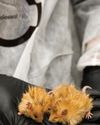Versuchen GOLD - Frei
SANJEEV SHARMA-TECHNOLOGY PIONEER
Muse Science Magazine for Kids
|May/June 2020
High-speed railroad cars, rockets, and now drones—what will mechanical engineer Sanjeev Sharma do next? Sharma is currently head of vehicle engineering at Matternet, a drone company in Mountain View, California. Whatever lies ahead, he’ll probably be at the forefront of new technologies that serve others.

“The common thread through all my career has been focused on technologies that help improve lives for a wide swath of people. I believe that is ultimately the wider purpose of engineering,” says Sharma. So it’s not surprising that Sharma is involved in the emerging technology of a new transportation mode: autonomous flying robots or drones. He also likes being a technology pioneer. “I like to work on things that haven’t existed before. Full autonomous drones in our urban airspaces are just the kind of change I’d like to work for,” says Sharma.

YOU’VE WORKED ON MANY NEW TECHNOLOGIES. TELL US ABOUT SOME OF THEM.
Before joining Matternet, I worked with Elon Musk at his company called SpaceX, working on the reusable rocket. Before that I worked in design of high-speed railroad cars for Indian Rail in India, where I’m from.

SOUNDS LIKE ADVANCED TRANSPORTATION IS YOUR SPECIALTY. HOW DID ROCKET ENGINEERING LEAD YOU INTO DRONES?
During my work at SpaceX, I learned a lot about aerodynamics and the design of reliable, fully autonomous flying vehicles—drones. Drones, like self-driving cars, will open up a new world. I grew intrigued by this possibility and was excited to join Matternet in 2018, as they are pioneers in this emerging technology.
WHAT ARE DOING NOW AT MATTERNET?
Diese Geschichte stammt aus der May/June 2020-Ausgabe von Muse Science Magazine for Kids.
Abonnieren Sie Magzter GOLD, um auf Tausende kuratierter Premium-Geschichten und über 9.000 Zeitschriften und Zeitungen zuzugreifen.
Sie sind bereits Abonnent? Anmelden
WEITERE GESCHICHTEN VON Muse Science Magazine for Kids

Muse Science Magazine for Kids
ANIMAL FIREFIGHTER TO THE RESCUE
Can animals help manage the risks of deadly wildfires?
3 mins
Muse July 2025: The Story Behind Wildfires

Muse Science Magazine for Kids
FIRE DANGER
WHY THE RISK OF WILDFIRES KEEPS GROWING
4 mins
Muse July 2025: The Story Behind Wildfires

Muse Science Magazine for Kids
The Miller NEW Normal
WHAT TODAY’S WILDFIRES TELL US ABOUT OUR FUTURE
8 mins
Muse July 2025: The Story Behind Wildfires

Muse Science Magazine for Kids
WOMEN AND FIREFIGHTING: A GOOD FIT
Jessica Gardetto is a firefighter. Her father was, too. “I grew up with my dad coming home smelling like wildfire and covered in soot,” she says.
1 min
Muse July 2025: The Story Behind Wildfires

Muse Science Magazine for Kids
What is happening on your fingertips when they get all wrinkly in a hot tub?
—Felix G., age 10, Montana
1 mins
Muse July 2025: The Story Behind Wildfires

Muse Science Magazine for Kids
WHEN the SMOKE CLEARS
THE LINGERING EFFECTS OF THE RECENT PACIFIC PALISADES AND ALTADENA EATON FIRES
6 mins
Muse July 2025: The Story Behind Wildfires

Muse Science Magazine for Kids
PICKING TEAMS
Keep it fair with a strategy that relies on geometry.
2 mins
Muse July 2025: The Story Behind Wildfires

Muse Science Magazine for Kids
SHAN CAMMACK
WILDLIFE BIOLOGIST AND FIRE SAFETY OFFICER
3 mins
Muse July 2025: The Story Behind Wildfires

Muse Science Magazine for Kids
Scientists Create Mice With Woolly Mammoth-Like Fur
RESEARCHERS AT A COMPANY IN TEXAS ARE WORKING TO CREATE A LIVING ANIMAL THAT RESEMBLES THE EXTINCT WOOLLY MAMMOTH. Recently, they produced mice with traits of the large mammal. The mice all have coats with mammoth-like fur, and some of the small mammals also have genes that help them store fat. Both features would help the animals survive in the cold Arctic, where the woolly mammoth once lived.
1 min
Muse July 2025: The Story Behind Wildfires

Muse Science Magazine for Kids
Cool Sunshade Added to the Nancy Roman Space Telescope
THE NANCY ROMAN SPACE TELESCOPE IS A NEW TELESCOPE THAT NASA IS BUILDING AND WILL LAUNCH INTO SPACE, LIKELY IN EARLY 2027.
1 min
Muse July 2025: The Story Behind Wildfires
Translate
Change font size

